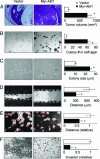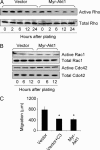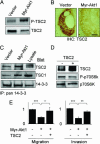Mechanism of Akt1 inhibition of breast cancer cell invasion reveals a protumorigenic role for TSC2
- PMID: 16537497
- PMCID: PMC1390746
- DOI: 10.1073/pnas.0511342103
Mechanism of Akt1 inhibition of breast cancer cell invasion reveals a protumorigenic role for TSC2
Abstract
Akt1 is frequently up-regulated in human tumors and has been shown to accelerate cell proliferation and to suppress programmed cell death; consequently, inhibition of the activity of Akt1 has been seen as an attractive target for therapeutic intervention. Paradoxically, hyperactivation of the Akt1 oncogene can also prevent the invasive behavior that underlies progression to metastasis. Here we show that overexpression of activated myr-Akt1 in human breast cancer cells phosphorylates and thereby targets the tumor suppressor tuberous sclerosis complex 2 (TSC2) for degradation, leading to reduced Rho-GTPase activity, decreased actin stress fibers and focal adhesions, and reduced motility and invasion. Overexpression of TSC2 rescues the migration phenotype of myr-Akt1-expressing tumor cells, and high levels of TSC2 in breast cancer patients correlate with increased metastasis and reduced survival. These data indicate that the functional properties of genes designated as oncogenes or tumor suppressor genes depend on the context of the cell type and the tissues studied, and suggest the need for caution in designing therapies targeting the function of individual genes in epithelial tissues.
Conflict of interest statement
Conflict of interest statement: No conflicts declared.
Figures





Similar articles
-
RhoC GTPase, a novel transforming oncogene for human mammary epithelial cells that partially recapitulates the inflammatory breast cancer phenotype.Cancer Res. 2000 Oct 15;60(20):5832-8. Cancer Res. 2000. PMID: 11059780
-
RhoBTB2 (DBC2) functions as tumor suppressor via inhibiting proliferation, preventing colony formation and inducing apoptosis in breast cancer cells.Gene. 2011 Oct 15;486(1-2):74-80. doi: 10.1016/j.gene.2011.07.018. Epub 2011 Jul 23. Gene. 2011. PMID: 21801820
-
Role of PI3K and AKT specific isoforms in ovarian cancer cell migration, invasion and proliferation through the p70S6K1 pathway.Cell Signal. 2006 Dec;18(12):2262-71. doi: 10.1016/j.cellsig.2006.05.019. Epub 2006 Jun 2. Cell Signal. 2006. PMID: 16839745
-
Cell biology of the movement of breast cancer cells: intracellular signalling and the actin cytoskeleton.Cancer Lett. 2009 Nov 1;284(2):122-30. doi: 10.1016/j.canlet.2009.02.034. Epub 2009 Mar 19. Cancer Lett. 2009. PMID: 19303207 Review.
-
A knotty turnabout?: Akt1 as a metastasis suppressor.Cancer Cell. 2005 Dec;8(6):437-9. doi: 10.1016/j.ccr.2005.11.006. Cancer Cell. 2005. PMID: 16338656 Review.
Cited by
-
Active PI3K pathway causes an invasive phenotype which can be reversed or promoted by blocking the pathway at divergent nodes.PLoS One. 2012;7(5):e36402. doi: 10.1371/journal.pone.0036402. Epub 2012 May 3. PLoS One. 2012. PMID: 22570710 Free PMC article.
-
Co-Administration of Fish Oil With Signal Transduction Inhibitors Has Anti-Migration Effects in Breast Cancer Cell Lines, in vitro.Open Biochem J. 2018 Aug 31;12:130-148. doi: 10.2174/1874091X01812010130. eCollection 2018. Open Biochem J. 2018. PMID: 30288178 Free PMC article.
-
AKT1 Transcriptomic Landscape in Breast Cancer Cells.Cells. 2022 Jul 25;11(15):2290. doi: 10.3390/cells11152290. Cells. 2022. PMID: 35892586 Free PMC article.
-
Suppression of Akt1-β-catenin pathway in advanced prostate cancer promotes TGFβ1-mediated epithelial to mesenchymal transition and metastasis.Cancer Lett. 2017 Aug 28;402:177-189. doi: 10.1016/j.canlet.2017.05.028. Epub 2017 Jun 7. Cancer Lett. 2017. PMID: 28602980 Free PMC article.
-
Akt isoform-specific effects on thyroid cancer development and progression in a murine thyroid cancer model.Sci Rep. 2020 Oct 27;10(1):18316. doi: 10.1038/s41598-020-75529-0. Sci Rep. 2020. PMID: 33110146 Free PMC article.
References
-
- Chambers A. F., Groom A. C., MacDonald I. C. Nat. Rev. Cancer. 2002;2:563–572. - PubMed
-
- Friedl P., Wolf K. Nat. Rev. Cancer. 2003;3:362–374. - PubMed
-
- Jaffe A. B., Hall A. Annu. Rev. Cell Dev. Biol. 2005;21:247–269. - PubMed
-
- Gildea J. J., Harding M. A., Seraj M. J., Gulding K. M., Theodorescu D. Cancer Res. 2002;62:982–985. - PubMed
Publication types
MeSH terms
Substances
LinkOut - more resources
Full Text Sources
Other Literature Sources
Medical
Miscellaneous

